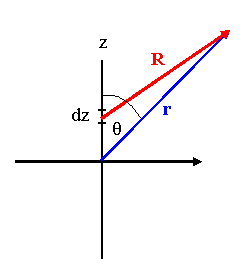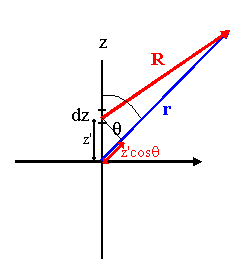Antennas
Problem:
Consider a linear antenna of length d (d << λ)
with a narrow gap in the center for the purposes of excitation. Assume
that the current is sinusoidal and in the same direction in each half of the
antenna, having a value of I0 at the gap and falling linearly to zero
at the ends. Find the power radiated in the electric dipole approximation.
Solution:
- Concepts:
Radiation from antennas, dipole radiation
- Reasoning:
We can treat the antenna as made up of small sections, each section emitting
dipole radiation.
- Details of the calculation:
Consider a small section of the antenna of length dz' located at z' . Treat it like a dipole.
Let p(z') = q(z')dz'(z/z), q(z') = q0(z')cosωt.
Then I(z') = dq(z')/dt = -ωq0(z')sinωt
= I0(z')sin(ωt), I0(z') = -ωq0(z').
p(z') = p0(z')cosωt. p0(z') = q0(z')dz
= -(I0(z')/ω)dz.
For dipole at the origin we have ER(r,t) = -(1/(4πε0c2r))ω2p0
cos(ω(t - r/c))sinθ (θ/θ).
A small section of the antenna of length dz' located at z' a distance
R
= r - (z/z)z' from the observation point therefore produces
dER(r,t) = (1/(4πε0c2R))ω2(I0(z')/ω)cos(ω(t - R/c))sinθ'dz' (θ'/θ').
dBR(r,t) = (1/(4πε0c3R))ω2(I0(z')/ω)cos(ω(t - R/c))sinθ'dz'(φ/φ).
Assume r >> λ, r >> z', d <<
λ.
Then θ' ≈ θ = constant, for all sections of the antenna.
We can also replace 1/R by 1/r and
cos(ωt - kR) by cos(ωt
- kr) because the changes in kR are small compared to π/2
over the length of the antenna. (k = ω/c)
I0(z) = I0 - (2I0/d)|z|, the current falls linearly to
zero at the ends.
Eθ(r,t) = ∫z=-d/2z=d/2dEθ(r,t)
= 2 ∫0z=d/2dEθ(r,t)
= (I0ω/(2πε0c2r))cos(ω(t - r/c))sinθ ∫0z=d/2(1 - 2z/d)dz'
= (I0d ω2/(8πε0c3))(1/(kr))cos(ω(t - r/c))sinθ.
Bφ(r,t) = ∫z=-d/2z=d/2dBφ(r,t)
= 2 ∫0z=d/2dBφ(r,t)
= (μ0I0d ω2/(8πc2))(1/(kr))cos(ω(t - r/c))sinθ.
S = (1/μ0)E×B
= (r/r)[(I02d2ω4/(64π2ε0c5k2r2))cos2(ω(t - r/c))sin2θ.]
P = (I02d2ω2/(64π2ε0c3r2))cos2(ω(t - r/c))
∫2πr2 sin3θ
dθ
= (I02d2ω2/(32πε0c3))cos2(ω(t - r/c))(4/3).
<P> = ½(I02d2ω2/(24πε0c3))
is the average power radiated in the electric dipole approximation.
Problem:
Assume an antenna is aligned with the z-axis and extends
from z = -λ/4 to z = +λ/4. Assume the current in the antenna varies as I(z,t) = I0sin(ωt)cos(kz).
Calculate the radiation fields ER and BR and the average
Poynting vector.
Solution:
- Concepts:
Radiation from antennas, dipole radiation
- Reasoning:
We can treat the antenna as made up of small sections, each section emitting
dipole radiation.
- Details of the calculation:
Consider a small section of the antenna. Treat it like a dipole.
Let p(z) = q(z) dz (z/z), q(z) = q0(z)cosωt.
Then I(z) = dq(z)/dt = -ωq0(z)sinωt
= I0(z)sin(ωt), I0(z) = -ωq0(z).
p(z) = p0(z)cosωt. p0(z) = q0(z)dz
= -(I0(z)/ω)dz.
Here I0(z) = I0cos(kz)
For dipole at the origin we have ER(r,t) = -(1/(4πε0c2r))ω2p0(0)
cos(ω(t - r/c))sinθ (θ/θ).
A small section of the antenna of length dz' located at z' a distance
R
= r - (z/z)z' from the observation point therefore produces
dER(r,t) = (1/(4πε0c2R))ω2(I0/ω)cos(ω(t
- R/c))sinθ'cos(kz')dz' (θ/θ).
dBR(r,t) = (1/(4πε0c3R))ω2(I0/ω)cos(ω(t
- R/c))sinθ'cos(kz')dz'(φ/φ).

dEθ(r,t) = (ω2I0/(4πε0c3))[cos(ω(t
- R/c))/kR]sinθ'cos(kz')dz',
dBφ(r,t) = (ω2I0/(4πε0c4))[cos(ω(t
- R/c)/kR]sinθ'cos(kz')dz',
with k = ω/c.
Eθ(r,t) = (ω2I0/(4πε0c3))∫[cos(ω(t
- R/c))/kR]sinθ'cos(kz')dz',
Bφ(r,t) = (ω2I0/(4πε0c4))∫[cos(ω(t
- R/c)/kR]sinθ'cos(kz')dz'.
The integration limits are -λ/4 and
λ/4.
Assume r >> λ, r >> z'.
Then θ' ≈ θ = constant for all sections of the antenna.
But cos(ωt - kR)
≠ cos(ωt
- kr) because kR changes by π/2 over the length of
the antenna. Although kR >> π/2, this changes
the phase drastically.
We use kR = kr - kz'cosθ for the argument of the
cosine function. We, however, can safely replace 1/R by 1/r.

We then have
Eθ(r,t) = (ω2I0sinθ/(4πε0c3kr))∫cos(ωt - kr + kz'cosθ)cos(kz')dz',
Bf(r,t) = (μ0ω2I0sinθ/(4πc2kr))∫cos(ωt - kr + kz'cosθ)cos(kz')dz'.
∫-λ/4λ/4cos(ωt - kr + kz'cosθ)cos(kz')dz'
= (1/k)cos(ωt - kr)∫-π/2π/2cos(kz'cosθ)cos(kz')dkz'
- (1/k)sin(ωt - kr)∫-π/2π/2sin(kz'cosθ)cos(kz')dkz'.
The second integral is zero, since it is an integral over an odd function of
z'.
∫-π/2π/2cos(ax) cos(x)dx
= sin((a-1)x)/(2(a-1)) + sin((a+1))x/(2(a+1))|-π/2π/2
= [1/(2(a-1))]{sinaxcosx-sinxcosax} + [1/(2(a+1))]{sinaxcosx+sinxcosax}|-π/2π/2
= [1/(2(a-1))]{-2cos(a(π/2))} +
[1/(2(a+1))]{2cos(a(π/2))}
= [1/(2(a2-1))]{-4cos(a(π/2))}
With a = cosθ ωe have
∫-π/2π/2cos(cosθx)cos(x)dx
= 2cos(cosθ(π/2))/(sin2θ).
Eθ(r,t) = [I0/(2πε0cr)]cos(ωt - kr)cos[(π/2)cosθ)]/sinθ.
Bf(r,t) = [μ0I0/(2πr)]cos(ωt - kr)cos[(π/2)cosθ)]/sinθ.
S = (1/μ0)E×B
=
(r/r)[I02/(4π2ε0cr2)]cos2(ωt -kr)cos2[(π/2)cosθ)]/sin2θ.
The plot below compares the angular radiation pattern of a dipole (sin2θ)
and a half-wave antenna (cos2[(π/2)cosθ)]/sin2θ).

Problem:
A very thin, straight, conducting wire is centered on the
origin of coordinates and is oriented along the z-axis. The wire carries a current
I = I0cos(ω0t) everywhere along its length
l.
(a) Obtain the vector potential everywhere outside the source region for distances
r >> l. Hint: Use the Lorentz gauge. Make no assumption about the value of the
wavelength, λ0 = 2πc/ω0.
(b) Obtain the dependence of the
intensity of the radiation pattern emitted by the wire on the
angle θ in the regime r >> l >> λ0.
Solution:
- Concepts:
Potentials in the Lorentz gauge
- Reasoning:
In the Lorentz gauge the expressions for the potentials
are
Φ(r, t) = [1/(4πε0)]∫v' dV' ρ(r',
tr)/|r - r'|,
A(r,t) = [μ0/(4π)]∫v'
dV' j(r', tr)/|r -
r'|.
tr = t - |r - r'|/c.
- Details of the calculation:
(a) Let r >> l. Then |r -
r'|
≈ r[1 - r∙r'/r],
1/|r - r'| ≈ (1/r)[1 + r∙r'/r].
Let j(r', t) = j(r')exp(-iω0t),
then A(r,t) = A(r)exp(-iω0t), with
A(r) = [μ0/(4π)]∫v'
dV' j(r')exp(ik|r - r'|)/|r -
r'| with
k = ω0/c.
Let j = I0δ(x)δ(y) k for -l/2 < z < l/2,
j
= 0 elsewhere.
Then A(r) = k [I0μ0/(4π)](eikr/r)∫-l/2l/2
dz'exp(-ik r∙r'/r).
(In the denominator keep only the zeroth order term and in the exponent keep
terms to first order.)
A(r) = k [I0μ0/(4π)](eikr/r)∫-l/2l/2
dz'exp(-ikz' cosθ)
= k [I0μ0/(4π)](eikr/r)[2/(k
cosθ)]sin(k(l/2) cosθ)
= k [1/(4πε0)][1/(cω0 cosθ)](2I0/r)sin(k(l/2)
cosθ)eikr.
(b) For r >> l >> λ0 we have only a radiation fields,
proportional to 1/r.
Then B = ∇×A = (1/r)[∂(rAθ)/∂r
-
∂Ar/∂θ](φ/φ)
≈ (1/r)[∂(rAθ)/∂r](φ/φ)
∝ [sinθ/cosθ]sin(k(l/2) cosθ).
The power per unit solid angle is proportional to |B2|.
dP/dΩ ∝ tan2θ sin2(k(l/2) cosθ).

k(l/2) = 2

k(l/2) = 20
As the ratio l/λ0 increases, more and more power is
emitted perpendicular to the wire.




